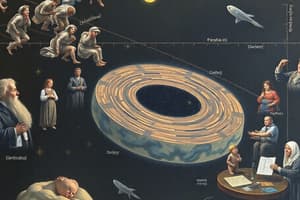Podcast
Questions and Answers
Which figure is known for advocating the heliocentric model of the universe?
Which figure is known for advocating the heliocentric model of the universe?
- Francis Bacon
- Isaac Newton
- Nicolaus Copernicus (correct)
- Galileo Galilei
Who is credited with the discovery of blood circulation?
Who is credited with the discovery of blood circulation?
- William Harvey (correct)
- Andreas Vesalius
- Rene Descartes
- Isaac Newton
Which scientist is associated with the inductive method of scientific inquiry?
Which scientist is associated with the inductive method of scientific inquiry?
- Francis Bacon (correct)
- Galileo Galilei
- Rene Descartes
- Margaret Cavendish
What was Margaret Cavendish known for in the context of the scientific revolution?
What was Margaret Cavendish known for in the context of the scientific revolution?
Which scientist is known for stating 'I think, therefore I am'?
Which scientist is known for stating 'I think, therefore I am'?
Flashcards
The Scientific Revolution
The Scientific Revolution
A period of significant advancements in science and scientific thought, primarily in Europe, during the 16th and 17th centuries.
Who was Galileo?
Who was Galileo?
An Italian astronomer, physicist, and engineer, considered a key figure in the Scientific Revolution. He made groundbreaking observations using the telescope, supporting the heliocentric model of the solar system, where the Earth revolves around the Sun.
Who was Copernicus?
Who was Copernicus?
A Polish astronomer who proposed the heliocentric model of the solar system, placing the Sun at the center and suggesting that the Earth and other planets revolve around it.
Who was Francis Bacon?
Who was Francis Bacon?
Signup and view all the flashcards
Who was Rene Descartes?
Who was Rene Descartes?
Signup and view all the flashcards
Study Notes
The Scientific Revolution
- The Scientific Revolution was a period of significant advancements in the fields of astronomy, physics, and biology beginning in the 16th century and continuing into the 18th century.
- It marked a shift from the predominant Aristotelian worldview to a more observation-based and mathematically oriented approach.
- Europe, particularly England, France, and Italy, was the primary center of activity during the revolution.
Key Figures and Their Contributions
- Nicolaus Copernicus (1473-1543): A Polish astronomer, Copernicus formulated the heliocentric model of the solar system, placing the Sun at the center, which challenged the established geocentric view.
- Galileo Galilei (1564-1642): An Italian astronomer, physicist, and engineer, Galileo supported the heliocentric model through observations with the telescope. He made significant contributions to understanding motion and inertia, challenging long-held Aristotelian physics. His work met with religious opposition.
- Johannes Kepler (1571-1630): A German astronomer who developed laws describing planetary motion that provided mathematical precision to Copernicus. Kepler's laws were crucial to the development of Newton's theory of gravitation.
- Francis Bacon (1561-1626): An English philosopher and statesman, Bacon emphasized the importance of inductive reasoning and empirical observation in scientific investigation. He developed a theory of scientific method, emphasizing experimentation and data collection.
- Rene Descartes (1596-1650): A French philosopher and mathematician, Descartes combined mathematical logic with observation to develop an important mechanistic view of the universe. His focus on deductive reasoning and mathematical principles contrasted with Bacon's inductive approach. Descartes also made important contributions to analytical geometry.
- Margaret Cavendish (1623-1673): An English aristocrat and natural philosopher, Cavendish questioned the rationalist assumptions of many leading male thinkers in the scientific revolution. She wrote many influential texts critically questioning the scientific view of the universe.
- Andreas Vesalius (1514-1564): A Flemish anatomist, Vesalius revolutionized the study of human anatomy by dissecting bodies and publishing accurate anatomical illustrations (De humani corporis fabrica). His work was meticulous and accurate, challenging the prevailing anatomical knowledge of the time.
- William Harvey (1578-1657): An English physician, Harvey examined the circulatory system of blood and published 'De Motu Cordis' (On the Motion of the Heart). He demonstrated that blood circulated through the body in a closed system, driven by the heart.
- Isaac Newton (1643-1727): An English physicist and mathematician, Newton developed the laws of motion and universal gravitation. These laws provided a comprehensive framework for understanding the physical world, unifying terrestrial and celestial mechanics and profoundly transforming scientific thought.
Studying That Suits You
Use AI to generate personalized quizzes and flashcards to suit your learning preferences.



